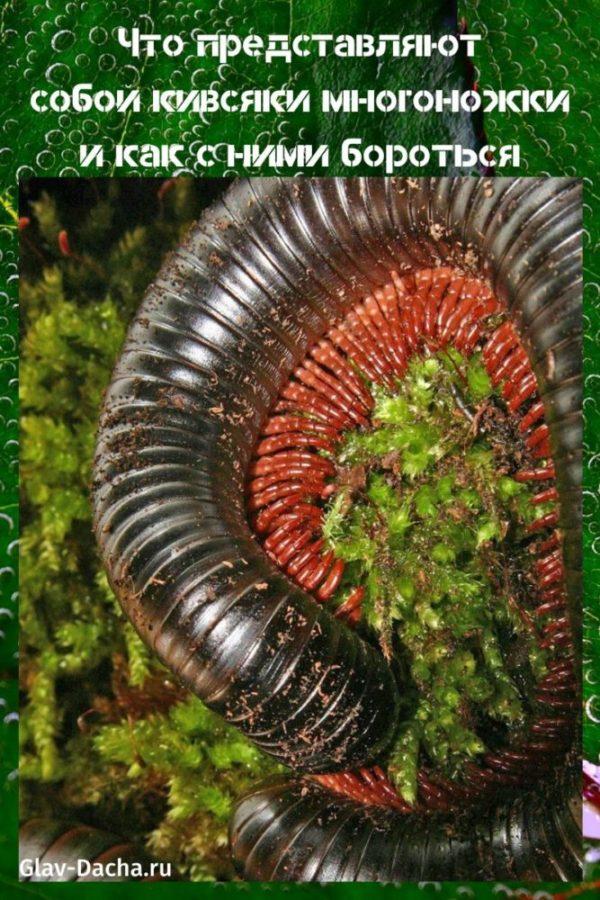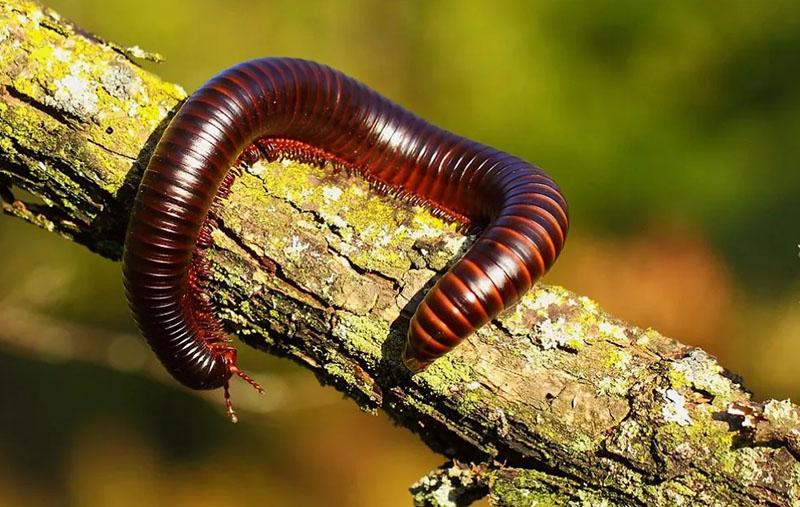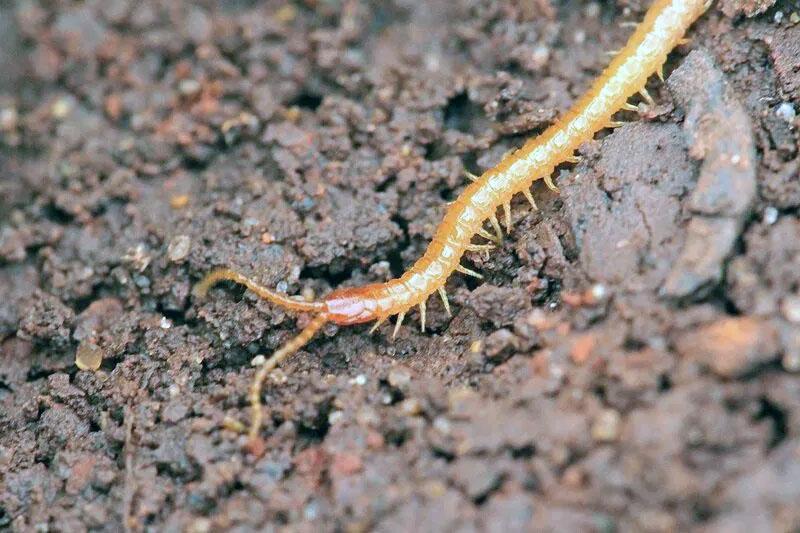What are centipedes kivsyaki and how to deal with them
 Centipede nodules or arthropod diplopods, on the trunk segments of which there are two pairs of legs (with the exception of four front and one rear), are found in many regions of the planet, with the exception of Antarctica. First of all, these are the inhabitants of forests in areas with a temperate climate, as well as numerous southern oak forests. They live in the forest litter, in which there is a lot of bark and various plants, broken branches.
Centipede nodules or arthropod diplopods, on the trunk segments of which there are two pairs of legs (with the exception of four front and one rear), are found in many regions of the planet, with the exception of Antarctica. First of all, these are the inhabitants of forests in areas with a temperate climate, as well as numerous southern oak forests. They live in the forest litter, in which there is a lot of bark and various plants, broken branches.

How do millipedes live and what they eat

The habitat of these slow creatures is inhabited by many bacteria, various invertebrates and insects:
- Kivsaki dig tunnels in the ground. They are active in the evening and at night.
- In cloudy weather, they can be found on the surface and in the daytime.
- In case of drought, when the top layer of the soil dries up, they safely go deeper, where moisture is still preserved.
- They usually burrow into the ground and freeze. Frightened by something, they abruptly curl up into a ring.
- Their fetid odor is associated with color. The brighter it is, the stronger the specific "aroma" emanating from the millipedes.
The food of the kivsyak is quite varied, and the volumes of food consumed are simply enormous. The weight of what was eaten per day is 1.5 times its own weight. In addition to mushrooms and tree leaves, kivsyaks are attracted by half-rotten tree branches, bark, and stems of dead plants. One could say that these are ordinary scavengers, mainly recycling plant waste. If not for one very important nuance. Kivsyaki breed with pleasure in manure, which is the best breeding ground for them. And therefore there are a lot of them in dachas and rural gardens.
Large numbers of kivsaki that have multiplied become pests that damage not only fruits, stems, but also the roots of many garden plants so much that their development slows down, they begin to "wither".
The dimensions of these creatures do not exceed 15 mm. They are also:
- white, yellow, brown, black and olive;
- with warts on the body;
- with sparse bristles.
Centipedes often get to the garden or summer cottage with manure mixed with straw. Therefore, when buying this organic fertilizer, which is very useful for many plants, you need to make sure that there are no larvae and adult creatures.
Kivsiak is sometimes confused with common worms or wireworms. In the garden, it can be found on potatoes and raspberries, strawberries, tomatoes, fallen apples. Young seedlings suffer from these millipedes, and the pest does not refuse germinating seeds.
How to get rid of kivsyaks in the country
 And although kivsaki are completely safe for humans, they are absolutely not safe for most crops grown in the garden. They can eat up potato roots raspberries, especially strawberries suffer from them. Because of this, many summer residents are looking for a way to get rid of kivsyak on strawberries. Weak jaws do not allow them to chew even the leaves, so they prefer the pulp of ripe berries.
And although kivsaki are completely safe for humans, they are absolutely not safe for most crops grown in the garden. They can eat up potato roots raspberries, especially strawberries suffer from them. Because of this, many summer residents are looking for a way to get rid of kivsyak on strawberries. Weak jaws do not allow them to chew even the leaves, so they prefer the pulp of ripe berries.
Usually the beds are protected quite simply:
- Strawberry bushes must be tied to pegs, it is impossible for the fruits to touch the ground and rot.
- The aisles need to be loosened periodically.
- Weeds should be uprooted and removed.
Greenhouses and greenhouses suffer the most from kivsiaks, since elfin foliage is one of the favorite types of food for these parasites.
And having multiplied, they begin to spoil other domestic cultures. You can get rid of them in various ways, it is worth considering the most popular and effective ones.
Bait
 This method is very popular among the people. The idea is to feed the parasites with small pieces of root vegetables that will be pumped up with insecticides. This method of how to deal with kivsyak without processing the entire area looks simple only at first glance. But the traps will need to be constantly looked after: maintain the desired level of moisture in the bait, protect them from rain, periodically renew and collect the kivsyak.
This method is very popular among the people. The idea is to feed the parasites with small pieces of root vegetables that will be pumped up with insecticides. This method of how to deal with kivsyak without processing the entire area looks simple only at first glance. But the traps will need to be constantly looked after: maintain the desired level of moisture in the bait, protect them from rain, periodically renew and collect the kivsyak.
In this regard, the method is simplified. Digging small (up to 10 cm deep) funnels or grooves. Empty jars are placed at the bottom. When trying to crawl over the trap, the parasite will simply fall to the bottom and will not be able to get out. The owner of the site only has to periodically collect them.
You can use soft pieces of potatoes, carrots, or other vegetables as bait. The creation of artificial shelters makes it possible to seriously facilitate the task of catching large individuals of the kivsyak, especially if they appeared on the site relatively recently and have not yet had time to breed, in this case it is even likely to completely clear the dacha of them. But if several colonies of these creatures are adjacent to one site, then the destruction in this case can imperceptibly turn into breeding.
Compost pits
 The bait method was also able to get quite interesting development. In addition to traps, pits such as compost pits can be used. They need to be filled with various organic waste that will attract kivsyak.
The bait method was also able to get quite interesting development. In addition to traps, pits such as compost pits can be used. They need to be filled with various organic waste that will attract kivsyak.
The resulting mixture must be regularly mixed, moistened and new layers added. If you cover it with a layer of turf, you can create an unfavorable environment for kivsyaks.
The effectiveness of the extermination of insects largely depends on the layer-by-layer treatment of the compost with chloride salts, such as sodium or potassium.
In late autumn, compost is usually scattered over the bed for freezing. This method is quite effective and makes it relatively easy to get rid of parasite colonies annually.
Chemical treatment
 Tilling the soil will not guarantee getting rid of kivsyaks, the reason for this is their strong chitinous shell. However, the effects of drugs can kill larvae and young insects. The approximate time from processing to the death of kivsyaks is from 5 hours to 5 days. Therefore, it is important to choose the right herbicides to get rid of the pests.
Tilling the soil will not guarantee getting rid of kivsyaks, the reason for this is their strong chitinous shell. However, the effects of drugs can kill larvae and young insects. The approximate time from processing to the death of kivsyaks is from 5 hours to 5 days. Therefore, it is important to choose the right herbicides to get rid of the pests.
As an option: composition "Aktofit", or "Karate" or "Thunder-2". The chemical compounds are unsafe, but if the planting holes are treated, the best effect can be achieved with minimal harm. Chloride salts are the most environmentally friendly solution to the problem. It is enough to add the substance to the soil in the evening, when insects begin to leave their shelters. This will lead to the fact that they begin to die. If applied correctly on the site, this method can quickly expel kivsyaks, however, it is advisable to repeat the procedures regularly throughout the season so that they do not return.
It is not worth processing the stems and seeds, it will not give an effect. Kivsiak does not eat the plant, he bites it more, because of which the poison may not work.
Centipede nodules: are preventive measures needed?
 A real result in the fight against centipedes in the garden is the sowing of green manure. They cannot stand the neighborhood with white mustard, which also improves the condition of the soil.
A real result in the fight against centipedes in the garden is the sowing of green manure. They cannot stand the neighborhood with white mustard, which also improves the condition of the soil.
It is very difficult to deal with kivsyaks that have bred in the garden, it is better to take care in advance that they do not get on the site:
- regularly liming the soil, use eggshells, ash, dolomite flour;
- check all planting material - roots and stems of seedlings;
- plant siderates, plants avoided by kivsaki - sunflower, white mustard, lupine, peas;
- use well-rotted manure or compost, check for pests.
If kivsyaki multiplied in the garden, the fight against them can be quite serious. To prevent this from happening, you need to get rid of places with high humidity in the garden, level the lowlands and loosen them regularly. Weeds must be destroyed in time. They must be removed from the soil and placed in a compost pit for complete decay.
Dig up the site before winter, should be as late as possible, so that the pests and larvae on the surface die from the cold. And in early spring, cultivation is necessary to freeze out most of the remaining pests.
For wintering, millipedes nodules choose uncultivated areas of land - near fences, non-dug aisles and many other places.